Analysis of the Thermally Induced Packaging Effects on the Frequency Drift of Micro-Electromechanical System Resonant Accelerometer
Abstract
:1. Introduction
2. Working Principle of MEMS Resonant Accelerometer and Frequency Drift Analysis
2.1. Working Principle of MEMS Resonant Accelerometer
2.2. Thermal Effects on the Frequency Drift of MEMS Resonant Accelerometer
3. MEMS Resonant Accelerometer Device and Package
3.1. MEMS Resonant Accelerometer Device
3.2. MEMS Resonant Accelerometer Package
3.3. Analysis of Thermally Induced Packaging Effects
4. Finite Element Simulations and Experimental Tests
4.1. Finite Element Modeling of MEMS Resonant Accelerometer
4.1.1. Geometric Model and Material Properties
4.1.2. Thermo-Mechanical-Modal Simulation Procedures
4.2. Temperature Tests for MEMS Resonant Accelerometer
5. Results and Discussions
5.1. Thermo-Mechanical Simulation Results
5.1.1. Thermal Deformation of MEMS Resonant Accelerometer
5.1.2. Thermo-Mechanical Stress of MEMS Resonant Accelerometer
5.2. Prestressed Modal Simulation Results
5.3. Influences of Packaging Structure Parameters on the Frequency Drift of MEMS Resonant Accelerometer
5.3.1. Influences of the Silicon Interlayer Thickness
5.3.2. Influences of the Thickness of Sn42Bi58 Solder Layer
5.3.3. Comparison of the Influences of the Packaging Structure Parameters
6. Conclusions
Author Contributions
Funding
Data Availability Statement
Acknowledgments
Conflicts of Interest
References
- Su, S.X.P.; Yang, H.S.; Agogino, A.M. A resonant accelerometer with two-stage micro-leverage mechanisms fabricated by SOI-MEMS technology. IEEE Sens. J. 2005, 5, 1214–1223. [Google Scholar] [CrossRef]
- Comi, C.; Corigliano, A.; Langfelder, G.; Longoni, A.; Tocchio, A.; Simoni, B. A resonant microaccelerometer with high sensitivity operating in an oscillating circuit. J. Microelectromech. Syst. 2010, 19, 1140–1152. [Google Scholar] [CrossRef]
- Le, X.L.; Kim, K.; Choa, S.H. Analysis of temperature stability and change of resonant frequency of a capacitive MEMS accelerometer. Int. J. Precis. Eng. Man. 2022, 23, 347–359. [Google Scholar] [CrossRef]
- Dong, J.; Qiu, A.; Shi, R. Temperature influence mechanism of micromechanical silicon oscillating accelerometer. In Proceedings of the 2011 IEEE Power Engineering and Automation Conference, Wuhan, China, 8–9 September 2011. [Google Scholar]
- Pandit, M.; Mustafazade, A.; Sobreviela, G.; Zhao, C.; Seshia, A.A. Experimental observation of temperature and pressure induced frequency fluctuations in silicon MEMS resonators. J. Microelectromech. Syst. 2021, 30, 500–505. [Google Scholar] [CrossRef]
- Kang, H.; Ruan, B.; Hao, Y.; Chang, H. A mode-localized resonant accelerometer with self-temperature drift suppression. IEEE Sens. J. 2020, 20, 12154–12165. [Google Scholar] [CrossRef]
- Huang, J.; Zhao, Y.; Xia, G.; Shi, Q.; Qiu, A.P. Accurate identification of the evolution of MEMS resonant accelerometer residual stresses at the wafer-die-chip level. J. Microelectromech. Syst. 2022, 31, 524–532. [Google Scholar] [CrossRef]
- Peng, B.; Hu, K.M.; Fang, X.Y.; Li, X.Y.; Zhang, W.M. Modal characteristics of coupled MEMS resonator array under the effect of residual stress. Sens. Actuators A Phys. 2022, 333, 113236. [Google Scholar] [CrossRef]
- Choa, S.H. Reliability of MEMS packaging: Vacuum maintenance and packaging induced stress. Microsyst. Technol. 2005, 11, 1187–1196. [Google Scholar] [CrossRef]
- Lishchynska, M.; O’Mahony, C.; Slattery, O.; Lishchynska, M. Evaluation of packaging effect on MEMS performance: Simulation and experimental study. IEEE Trans. Adv. Packag. 2007, 30, 629–635. [Google Scholar] [CrossRef]
- Melamud, R.; Chandorkar, S.A.; Kim, B.; Lee, H.K.; Salvia, J.C.; Bahl, G.; Hopcroft, M.A.; Kenny, T.W. Temperature-insensitive composite micromechanical resonators. J. Microelectromech. Syst. 2009, 18, 1409–1419. [Google Scholar] [CrossRef]
- Zotov, S.A.; Simon, B.R.; Trusov, A.A.; Shkel, A.M. High quality factor resonant MEMS accelerometer with continuous thermal compensation. IEEE Sens. J. 2015, 15, 5045–5052. [Google Scholar] [CrossRef]
- Yin, Y.; Fang, Z.; Dong, J.; Liu, Y.; Han, F. A temperature-insensitive micromachined resonant accelerometer with thermal stress isolation. In Proceedings of the 2018 IEEE Sensors, New Delhi, India, 28–31 October 2018. [Google Scholar]
- Salvia, J.C.; Melamud, R.; Chandorkar, S.A.; Lord, S.F.; Kenny, T.W. Real-time temperature compensation of MEMS oscillators using an integrated micro-oven and a phase-locked loop. J. Microelectromech. Syst. 2009, 19, 192–201. [Google Scholar] [CrossRef]
- Wang, S.; Zhu, W.; Shen, Y.; Ren, J.; Gu, H.; Wei, X. Temperature compensation for MEMS resonant accelerometer based on genetic algorithm optimized backpropagation neural network. Sens. Actuators A Phys. 2020, 316, 112393. [Google Scholar] [CrossRef]
- Guo, G.; Chai, B.; Cheng, R.; Wang, Y. Temperature drift compensation of a MEMS accelerometer based on DLSTM and ISSA. Sensors 2023, 23, 1809. [Google Scholar] [CrossRef]
- Gonzalez, M.; Jourdain, A.; Vandevelde, B.; Tilmans, H.A.C. Effect of thermomechanical stress on resonant frequency shift of a silicon MEMS resonator. In Proceedings of the EuroSimE 2008-International Conference on Thermal, Mechanical and Multi-Physics Simulation and Experiments in Microelectronics and Micro-Systems, Freiburg im Breisgau, Germany, 20–23 April 2008. [Google Scholar]
- Nishida, T.; Higo, Y.; Tanigawa, H.; Suzuki, K. Influence of packaging on frequency drift in MEMS resonators-dynamic effect of packaging on MEMS device performance. In Proceedings of the IEEE CPMT Symposium Japan 2014, Kyoto, Japan, 4–6 November 2014. [Google Scholar]
- Jiang, B.; Huang, S.; Zhang, J.; Su, Y. Analysis of frequency drift of silicon MEMS resonator with temperature. Micromachines 2020, 12, 26. [Google Scholar] [CrossRef]
- Zhao, C.; Song, J.; Han, L.; Huang, Q.A. Effects of thermally induced packaging stress on a distributed RF MEMS phase shifter. Microsyst. Technol. 2015, 21, 869–874. [Google Scholar] [CrossRef]
- Huang, L.; Yang, H.; Gao, Y.; Zhao, L.; Liang, J. Design and implementation of a micromechanical silicon resonant accelerometer. Sensors 2013, 13, 15785–15804. [Google Scholar] [CrossRef] [PubMed]
- Huang, J.; Zhao, Y.; Xia, G.M.; Shi, Q.; Qiu, A.P. Systematic modeling of a MEMS resonant accelerometer based on displacement coordination. IEEE Sens. J. 2022, 22, 6454–6465. [Google Scholar] [CrossRef]
- Hopkins, R.; Miola, J.; Sawyer, W.; Setterlund, R.; Dow, B. The silicon oscillating accelerometer: A high-performance MEMS accelerometer for precision navigation and strategic guidance applications. In Proceedings of the 2005 National Technical Meeting of the Institute of Navigation, San Diego, CA, USA, 24–26 January 2005. [Google Scholar]
- Cho, C.H. Characterization of Young’s modulus of silicon versus temperature using a “beam deflection” method with a four-point bending fixture. Curr. Appl. Phys. 2009, 9, 538–545. [Google Scholar] [CrossRef]
- Nejhad, M.N.G.; Pan, C.; Feng, H. Intrinsic strain modeling and residual stress analysis for thin-film processing of layered structures. J. Electron. Packag. 2003, 125, 4–17. [Google Scholar] [CrossRef]
- Hsueh, C.H. Thermal stresses in elastic multilayer systems. Thin Solid Film. 2002, 418, 182–188. [Google Scholar] [CrossRef]
- Liu, J.; Shi, Y.; Li, P.; Tang, J.; Zhao, R.; Zhang, H. Experimental study on the package of high-g accelerometer. Sens. Actuators A Phys. 2012, 173, 1–8. [Google Scholar] [CrossRef]
- Li, N.; Xing, C.; Sun, P.; Zhu, Z. Simulation analysis on thermal drift of MEMS resonant accelerometer. In Proceedings of the 2019 20th International Conference on Electronic Packaging Technology (ICEPT), Hong Kong, China, 12–15 August 2019. [Google Scholar]
- Tsai, M.Y.; Hsu, C.H.; Han, C.N. A note on Suhir’s solution of thermal stresses for a die-substrate assembly. J. Electron. Packag. 2004, 126, 115–119. [Google Scholar] [CrossRef]
- Liu, C.; Brem, F.; Riedel, G.; Eichelberger, E.; Hofmann, N. The influence of thermal cycling methods on the interconnection reliability evaluation within IGBT modules. In Proceedings of the 2012 4th Electronic System-Integration Technology Conference, Amsterdam, The Netherlands, 17–20 September 2012. [Google Scholar]
- Geng, J.; Lv, J.; Jin, K.; Ji, P.; Li, Y.Z.; Xue, Y.X.; Liu, Y. Stress simulation analysis of CIS interconnect solder joints under thermal cycling. In Proceedings of the 2022 23rd International Conference on Electronic Packaging Technology (ICEPT), Dalian, China, 10–13 August 2022. [Google Scholar]
- Zaal, J.J.M.; Driel, W.D.V.; Bendida, S.; Li, Q.; Beek, J.T.M.V.; Zhang, G.Q. Packaging influences on the reliability of MEMS resonators. Microelectron. Reliab. 2008, 48, 1567–1571. [Google Scholar] [CrossRef]

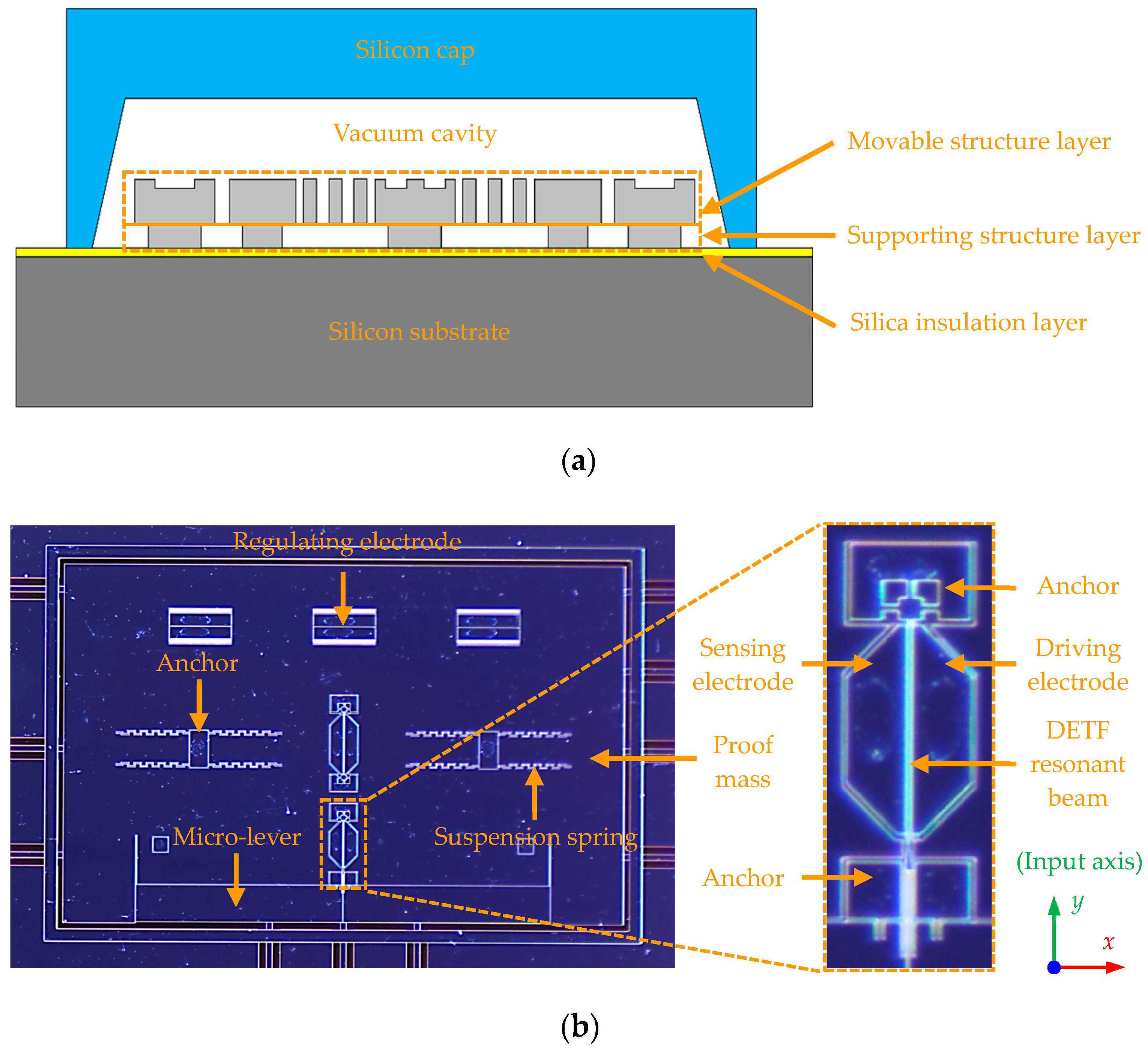


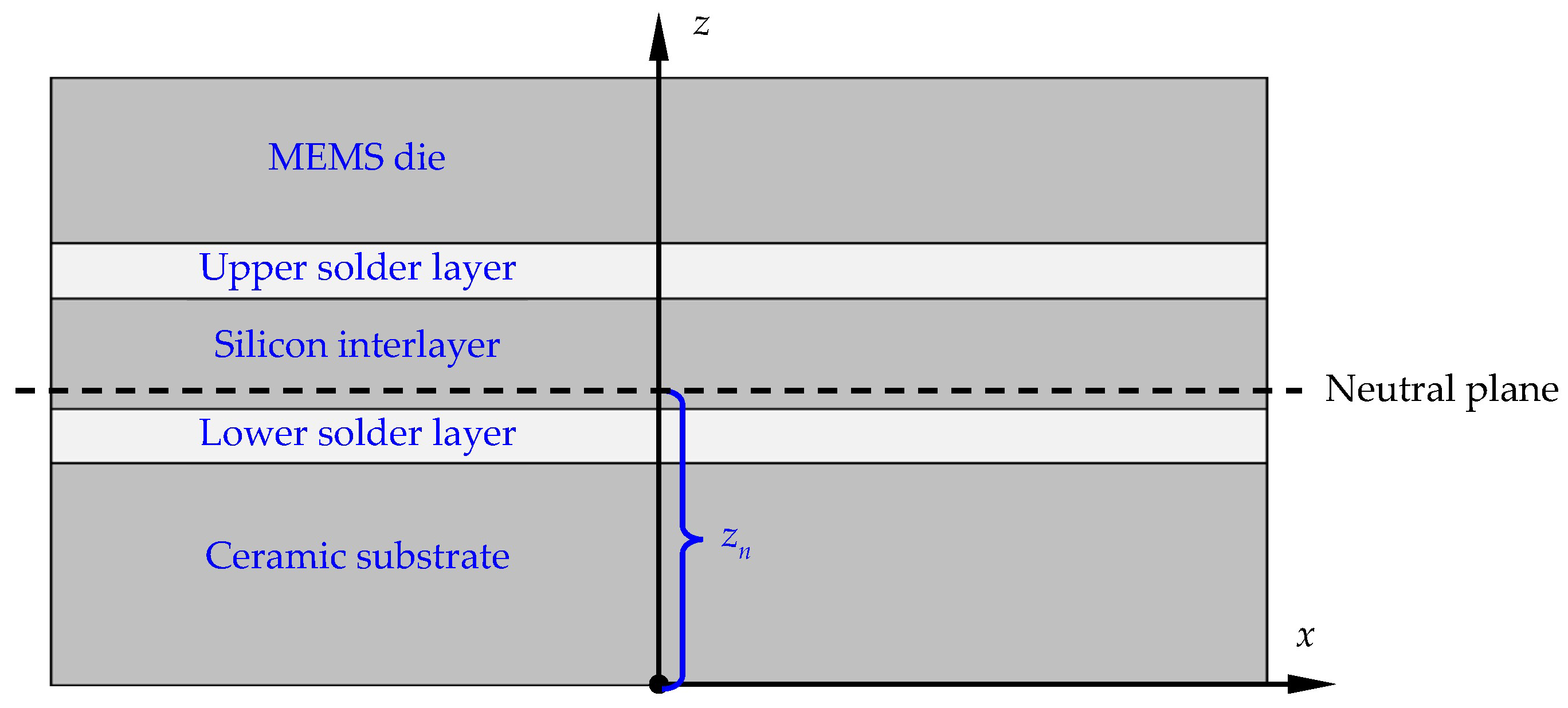
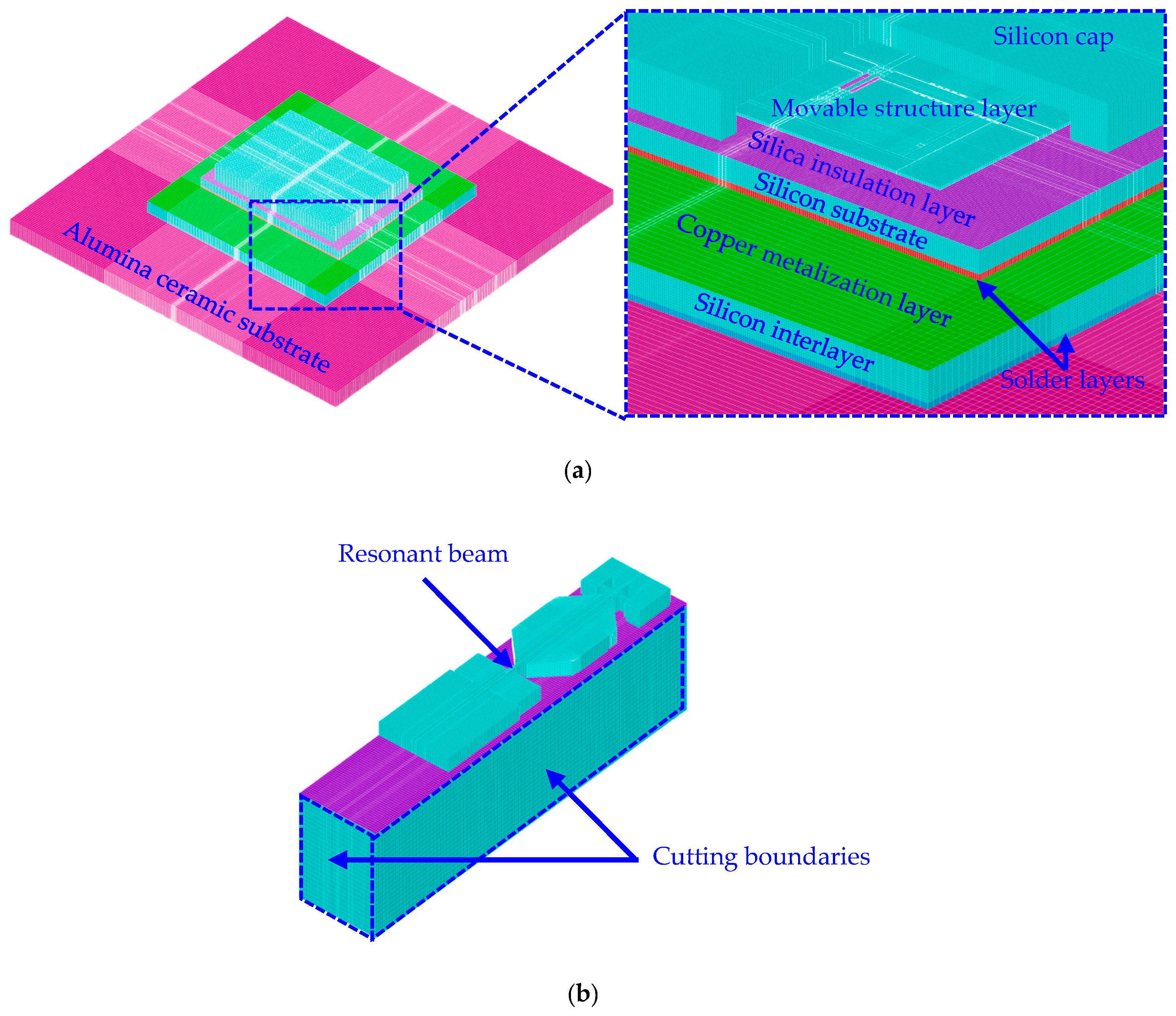

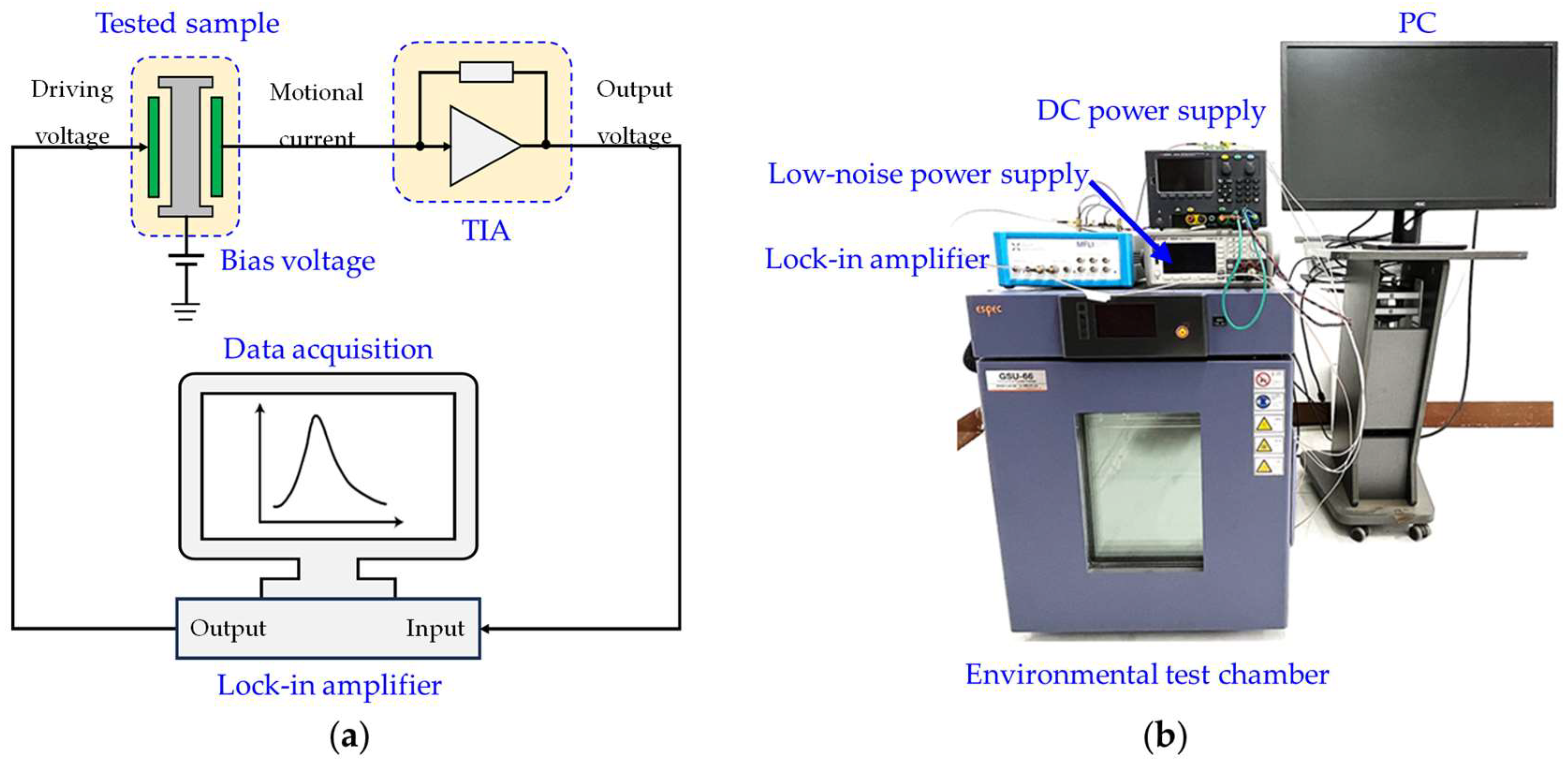

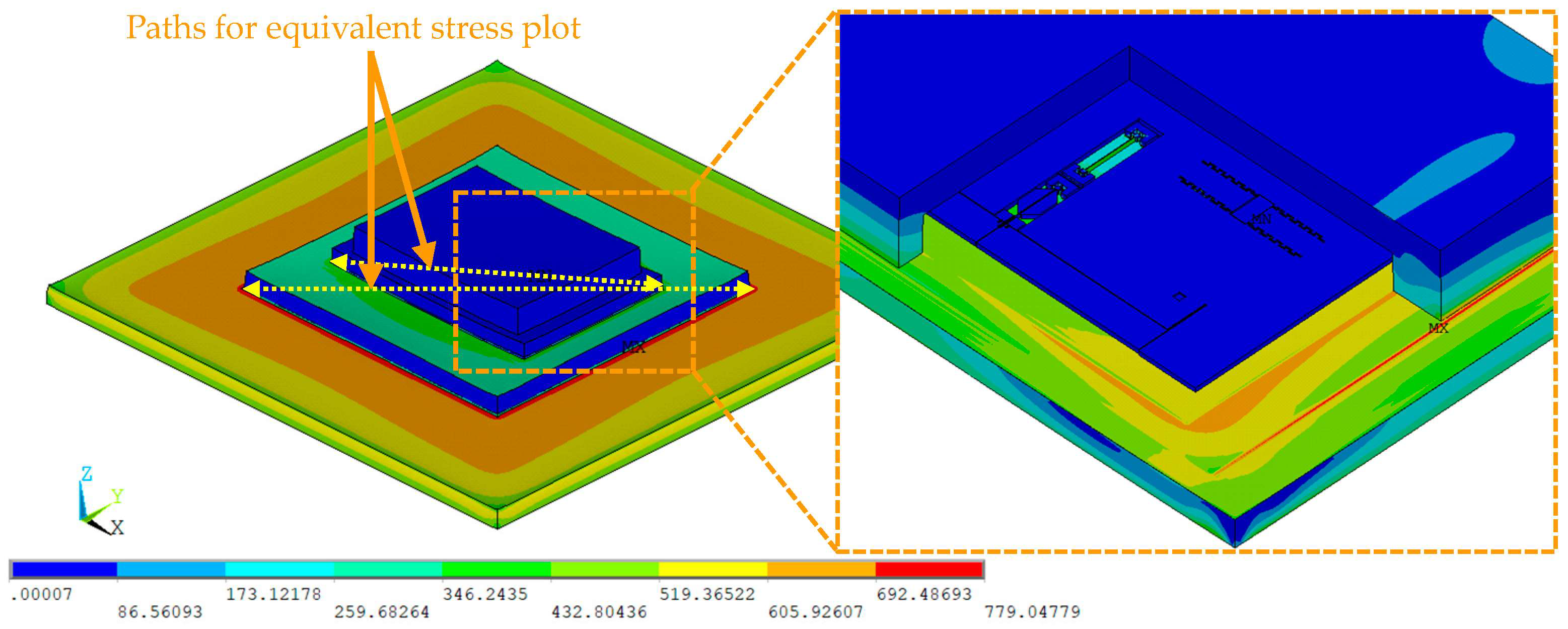

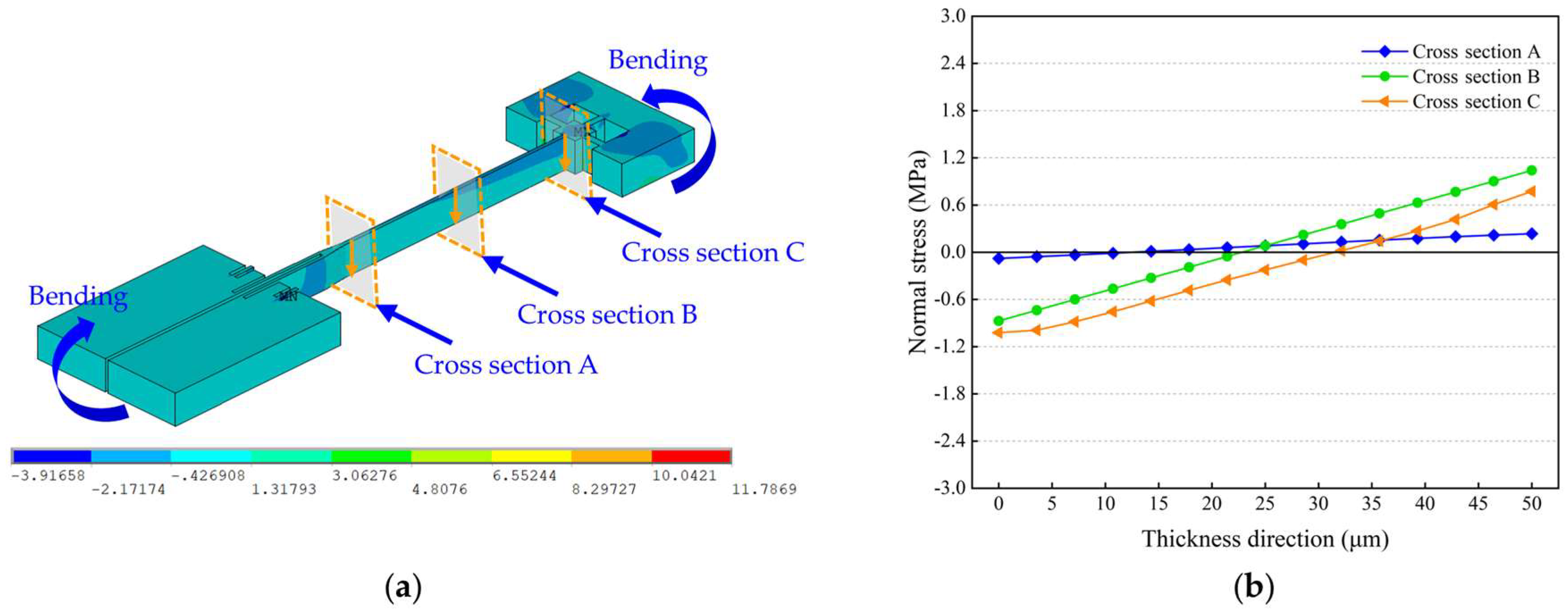
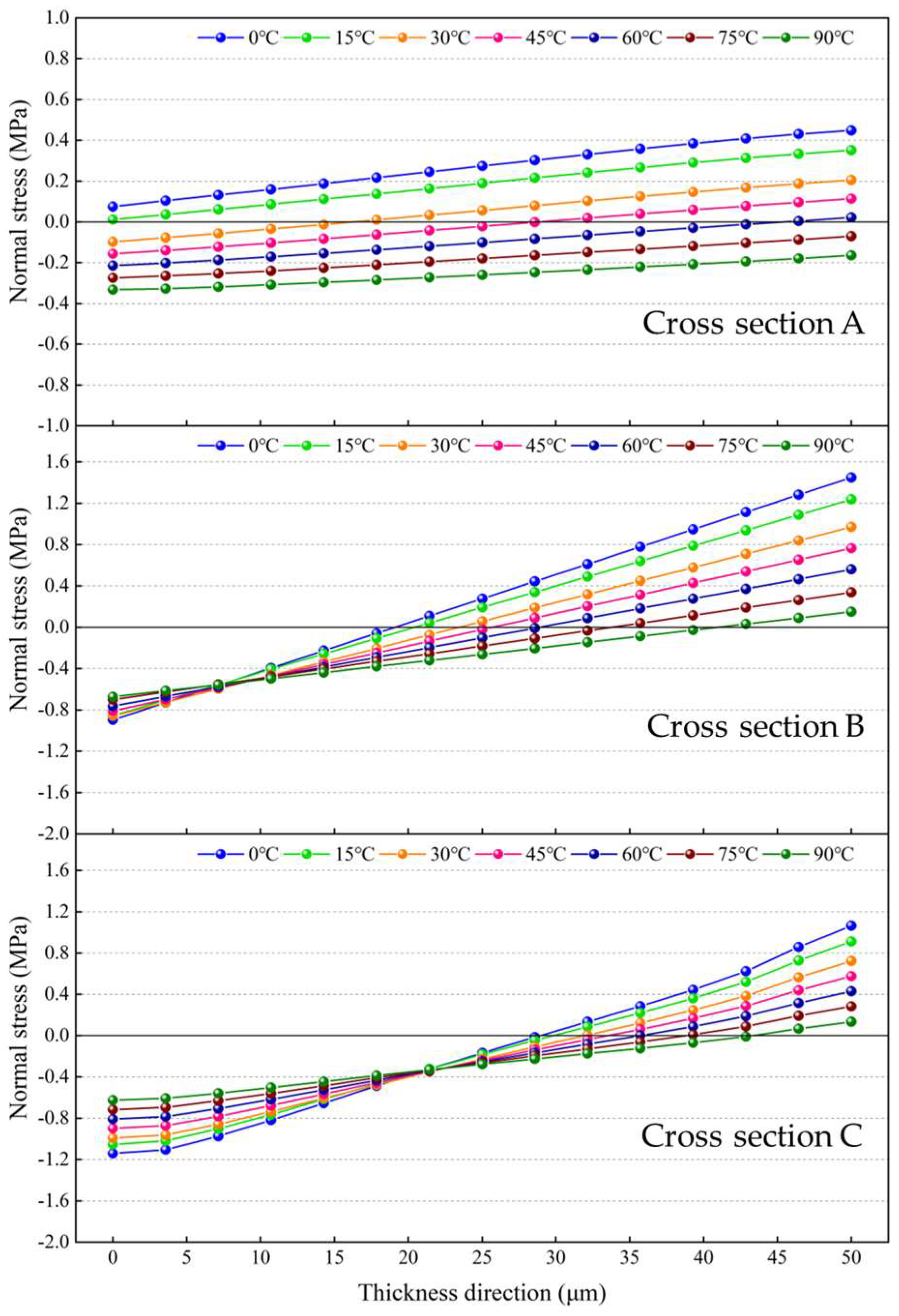

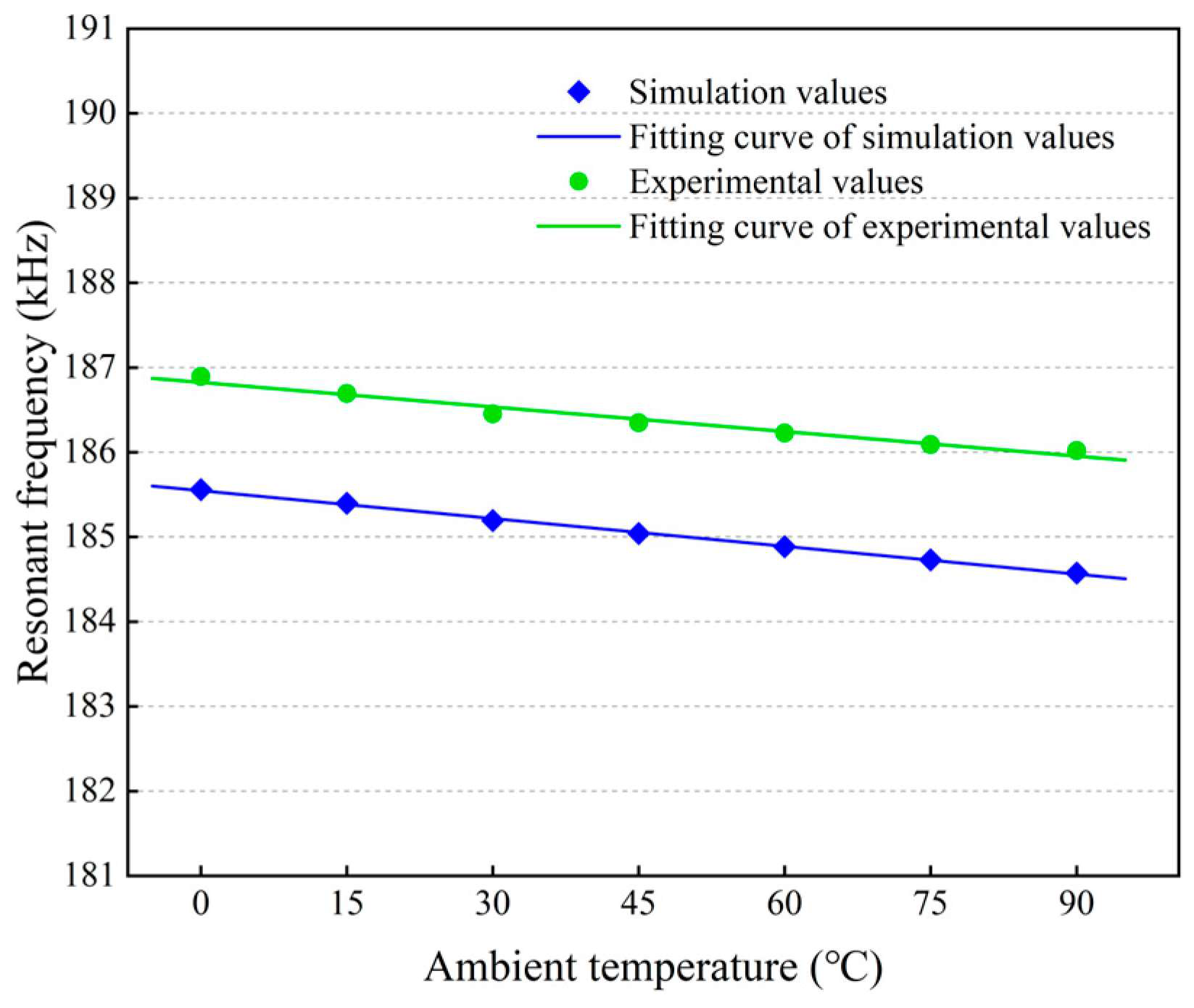
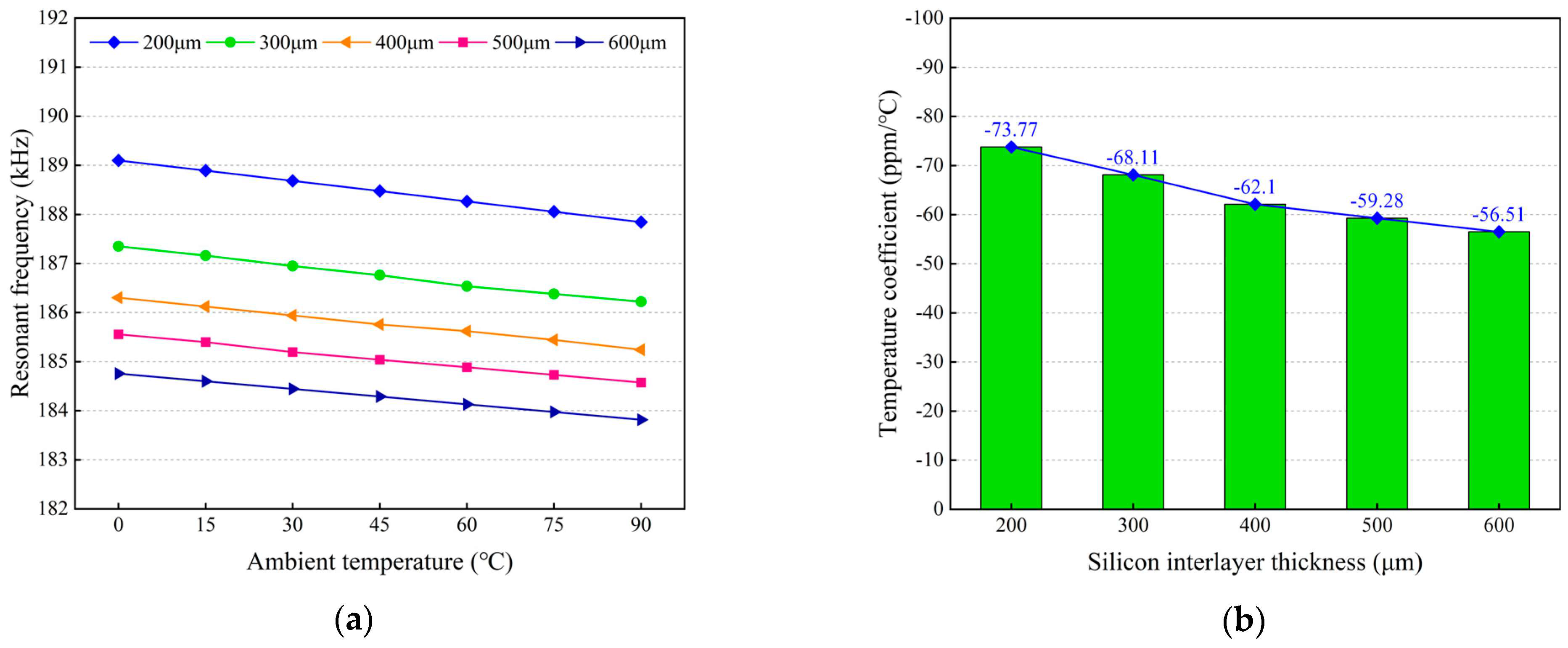
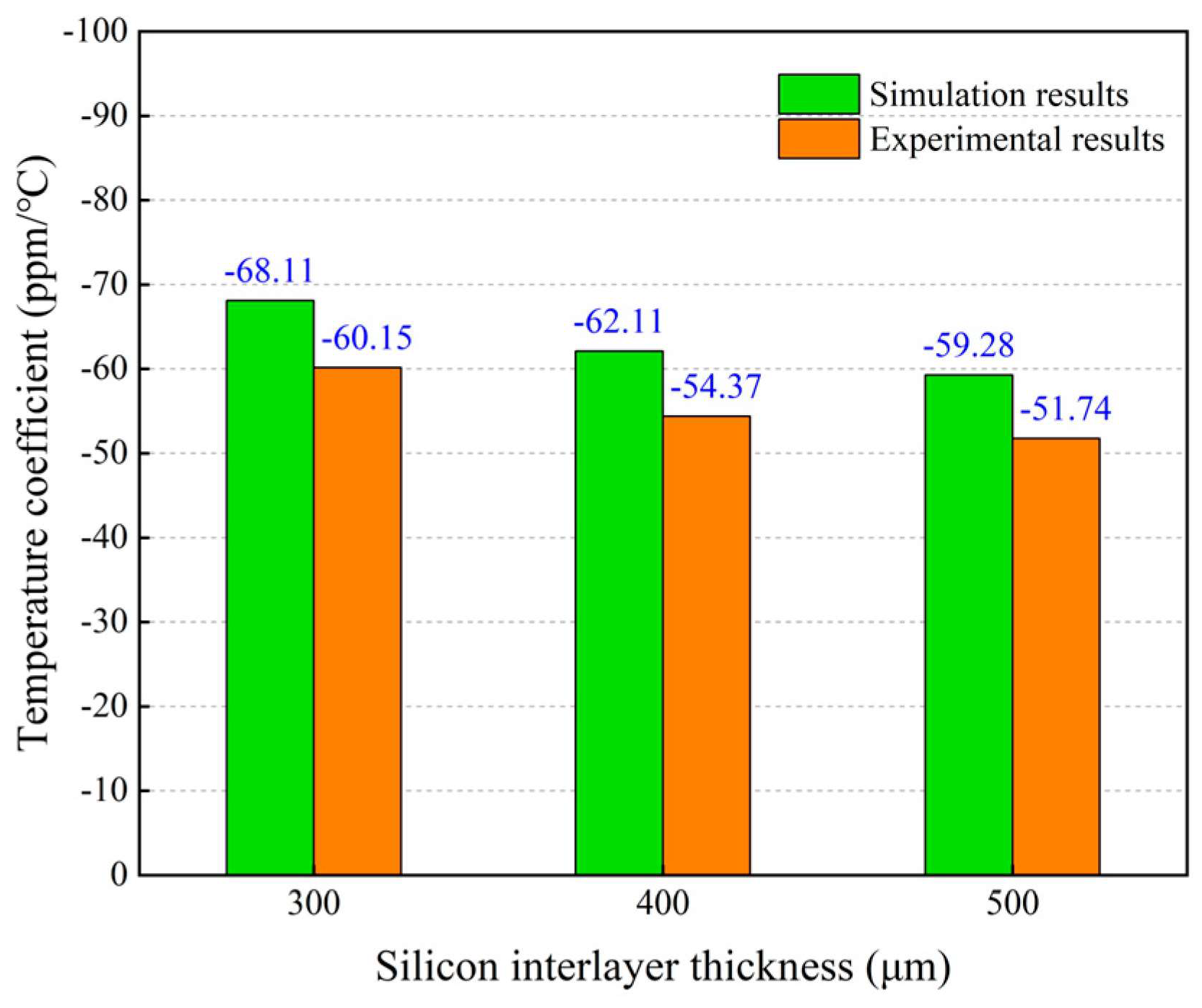
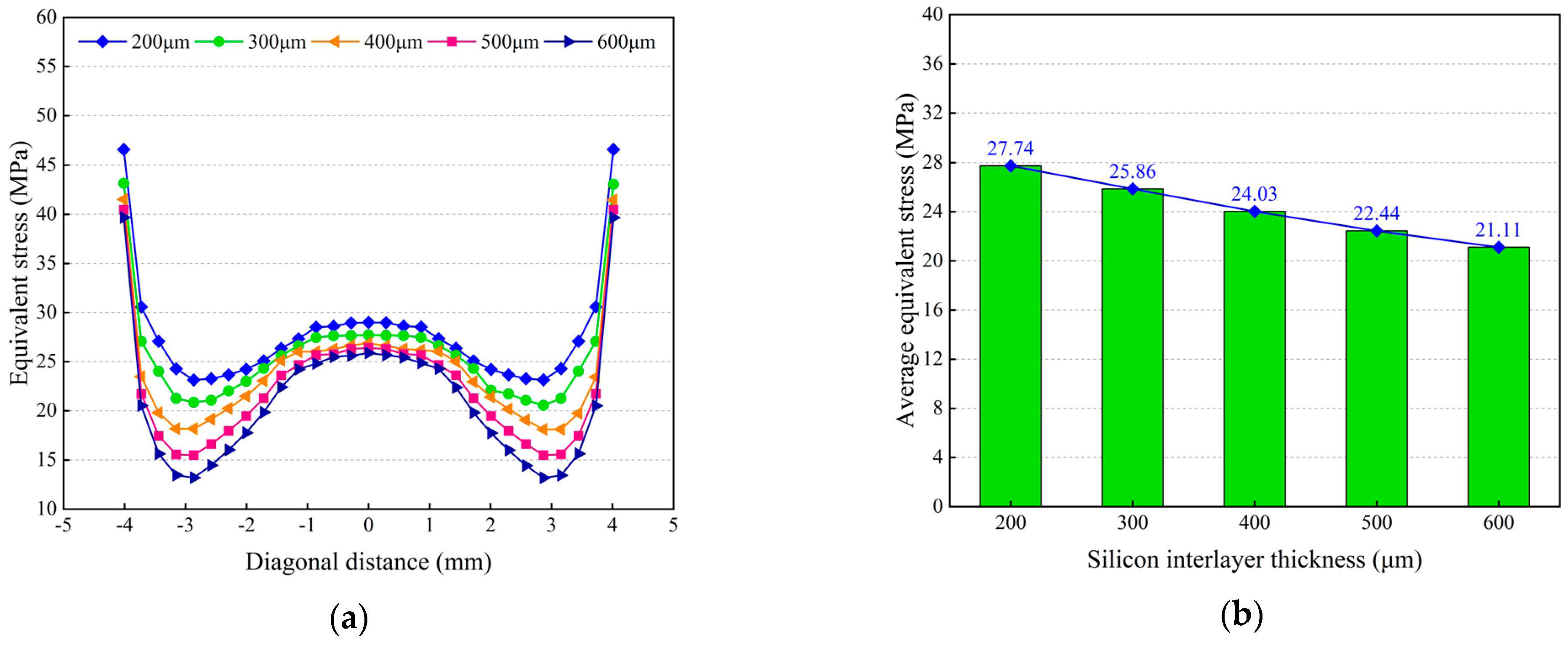


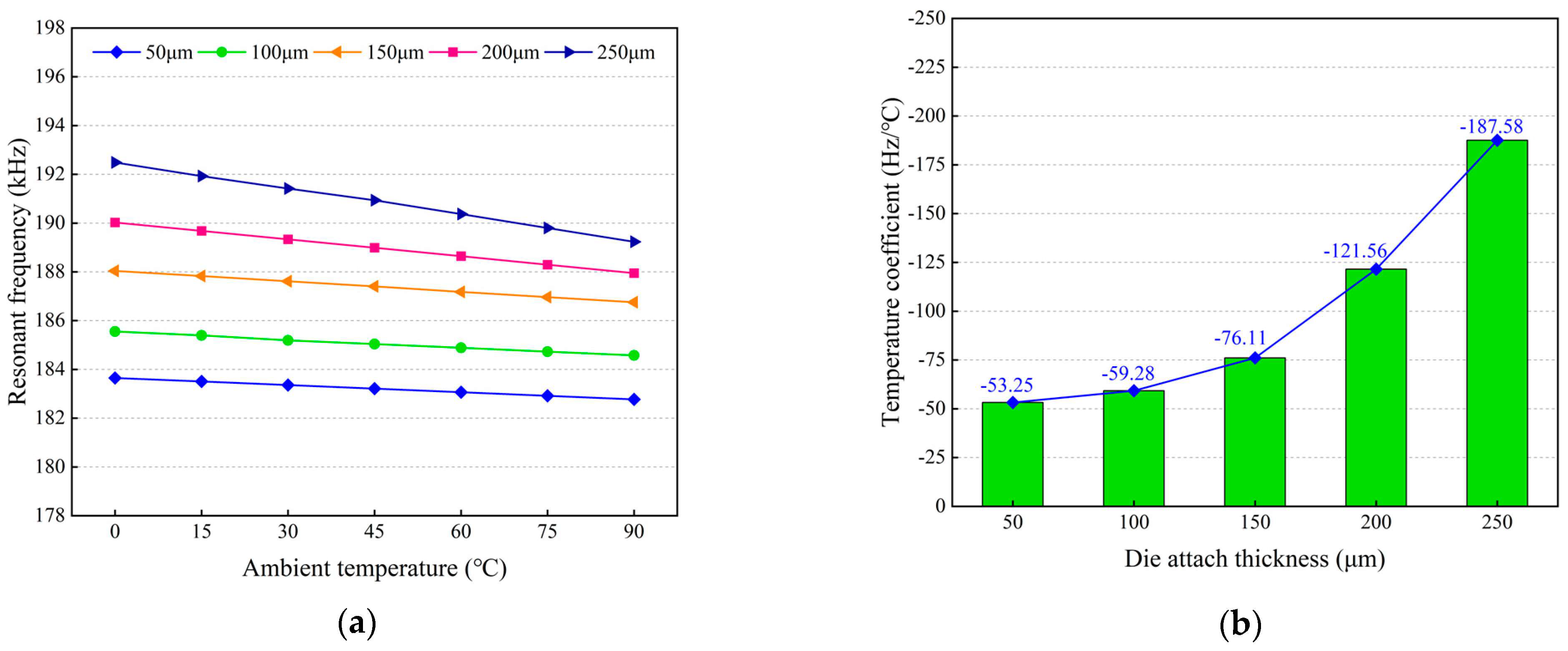
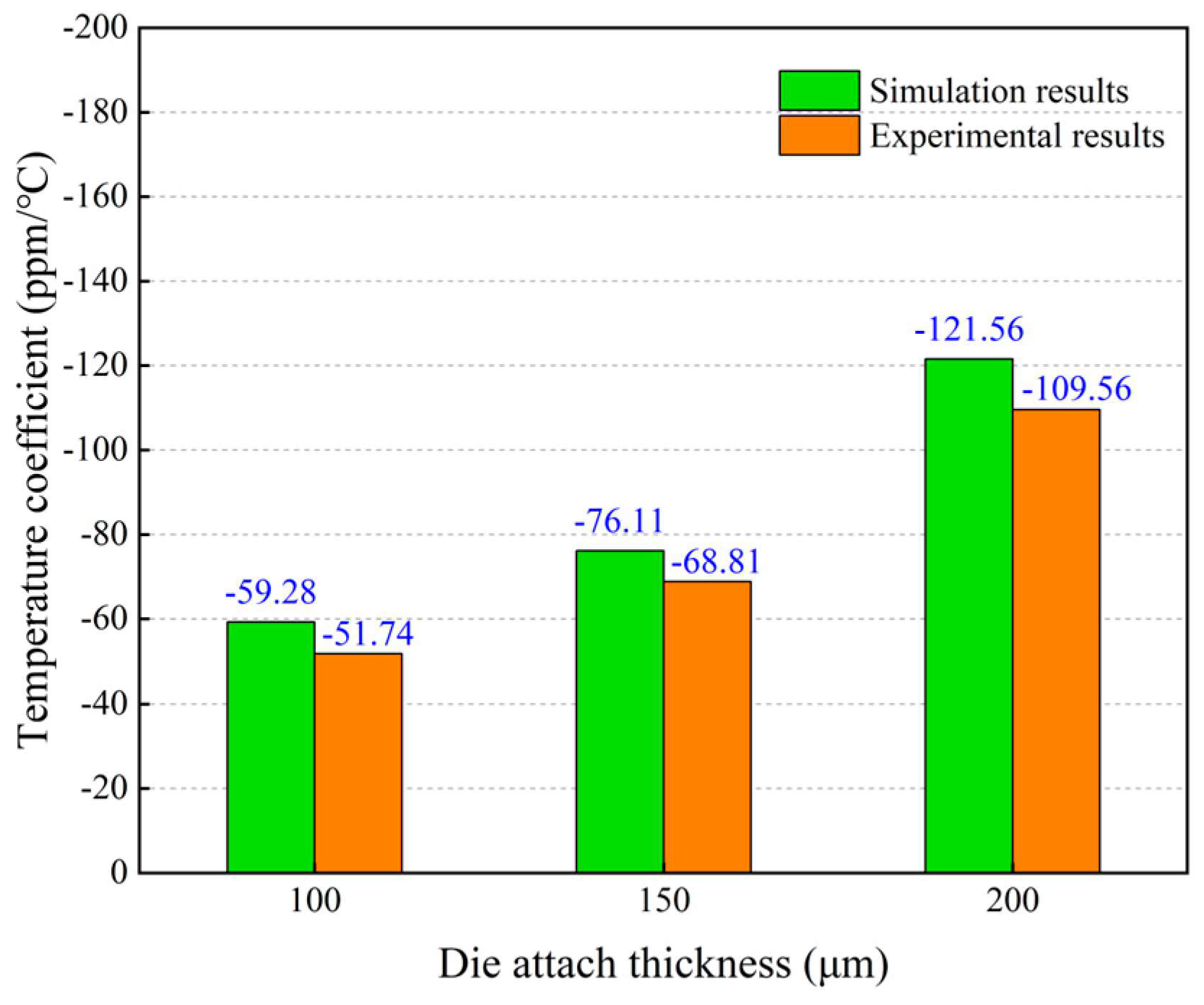
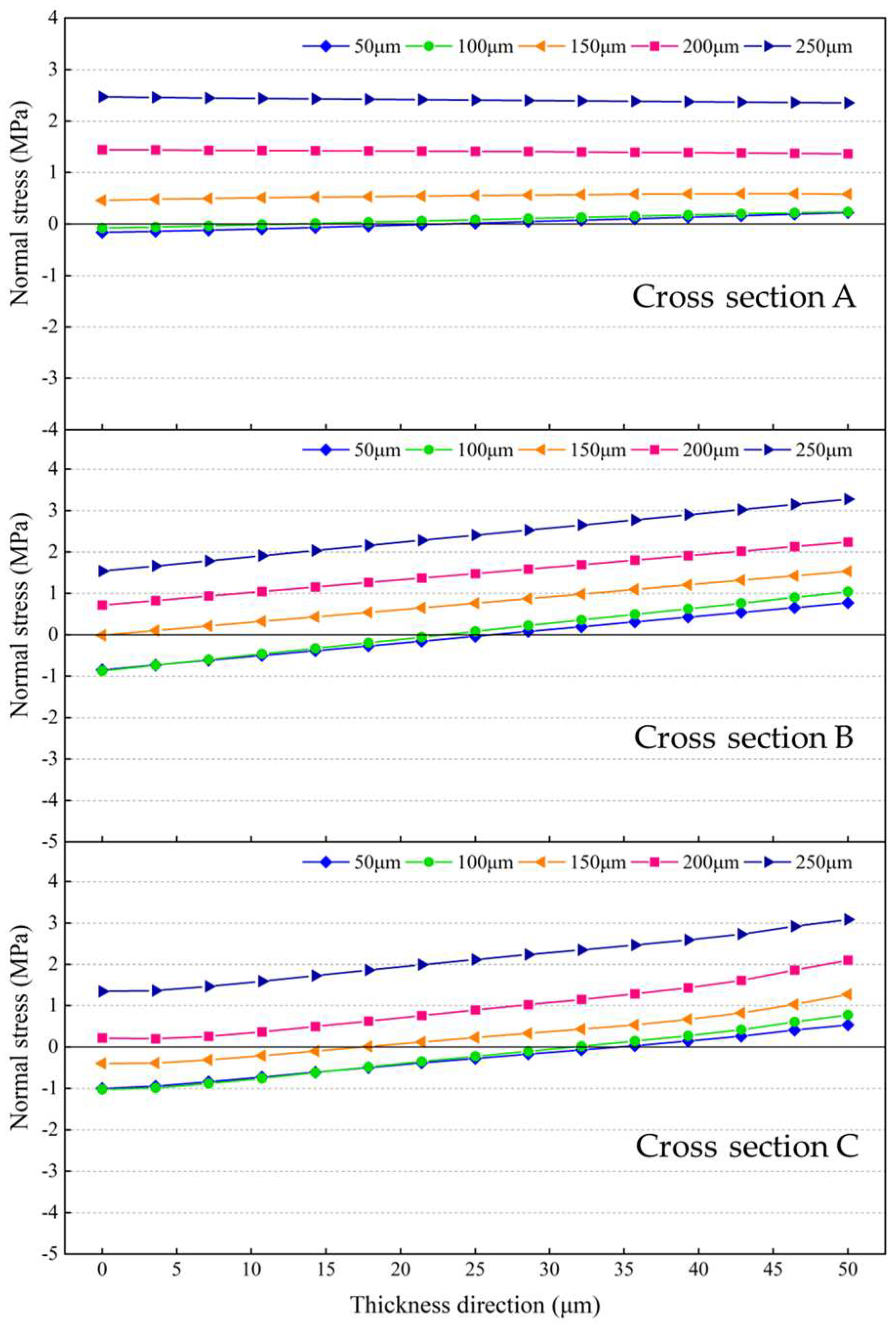
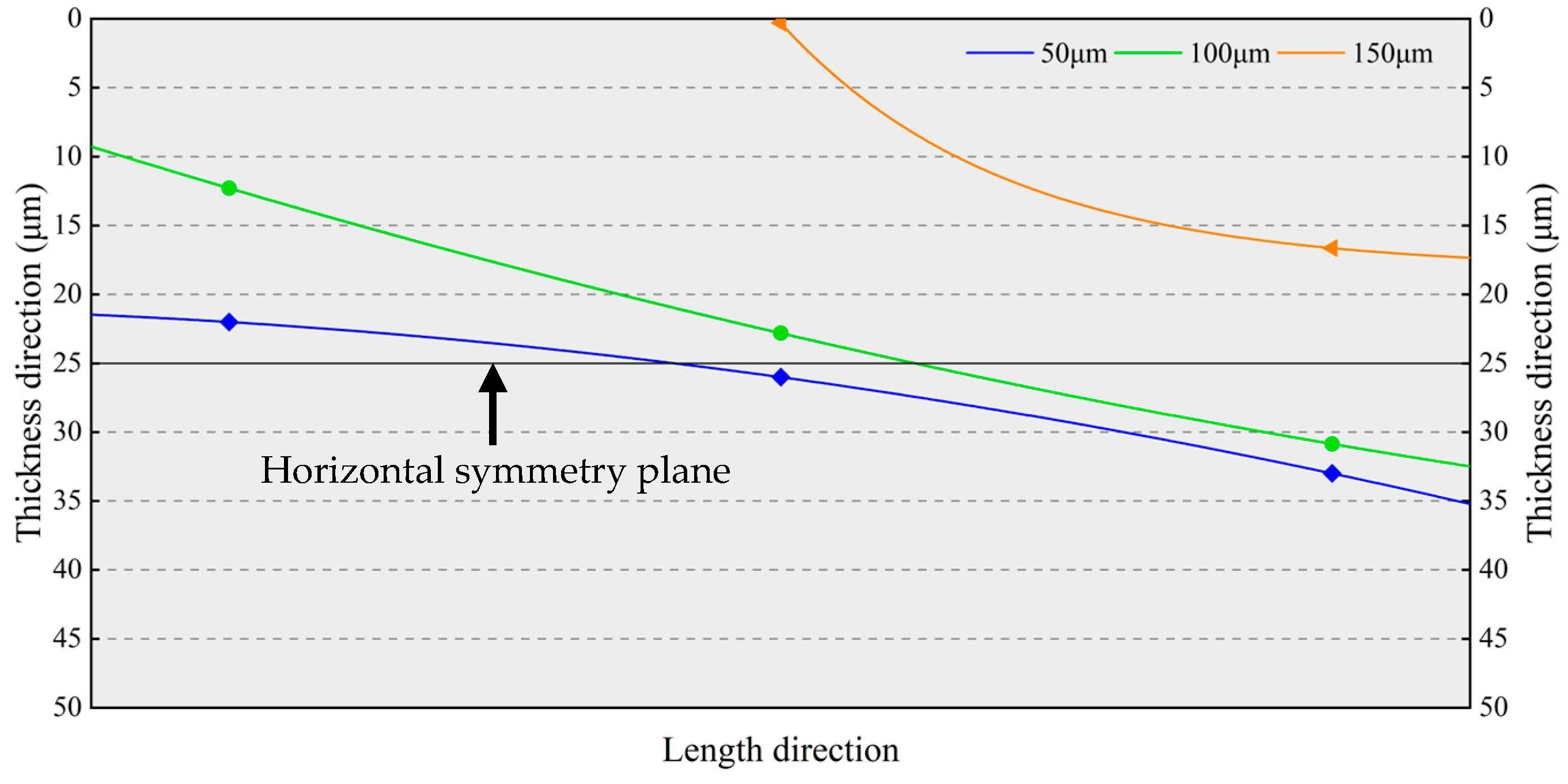
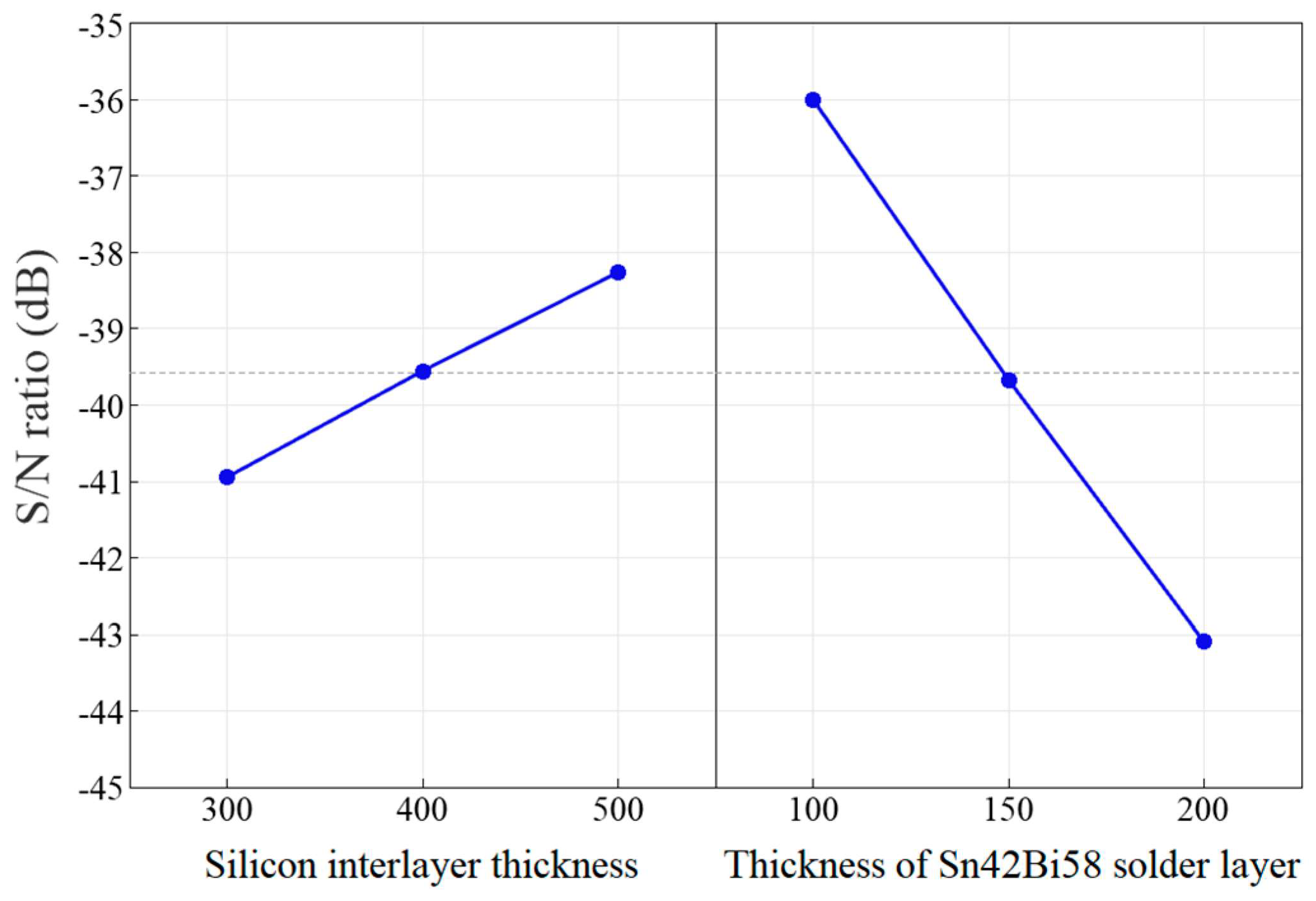
| Material | Young’s Modulus (GPa) | Poisson’s Ratio | CTE (ppm/°C) | Density (g/cm3) |
|---|---|---|---|---|
| Si [29] | Figure 8 | 0.28 | 2.60 | 2.33 |
| SiO2 | 70 | 0.20 | 0.35 | 2.50 |
| Cu | 129 | 0.35 | 16.90 | 8.92 |
| Al2O3 | 310 | 0.22 | 7.00 | 3.97 |
| SAC305 [30] | 55 | 0.36 | 17.00 | 7.30 |
| Sn42Bi58 [31] | 38 | 0.35 | 15.00 | 8.70 |
| Factor | Level 1 | Level 2 | Level 3 |
|---|---|---|---|
| Silicon interlayer thickness (μm) | 300 | 400 | 500 |
| Thickness of Sn42Bi58 solder layer (μm) | 100 | 150 | 200 |
| Combination | Silicon Interlayer Thickness (μm) | Thickness of Sn42Bi58 Solder Layer (μm) | Temperature Coefficient of Resonant Frequency (ppm/°C) | S/N Ratio (dB) |
|---|---|---|---|---|
| A | 300 | 100 | −68.11 | −36.66 |
| B | 300 | 150 | −122.62 | −41.77 |
| C | 300 | 200 | −165.80 | −44.39 |
| D | 400 | 100 | −62.11 | −35.86 |
| E | 400 | 150 | −95.51 | −39.60 |
| F | 400 | 200 | −144.41 | −43.19 |
| G | 500 | 100 | −59.28 | −35.46 |
| H | 500 | 150 | −76.11 | −37.63 |
| I | 500 | 200 | −121.56 | −41.70 |
Disclaimer/Publisher’s Note: The statements, opinions and data contained in all publications are solely those of the individual author(s) and contributor(s) and not of MDPI and/or the editor(s). MDPI and/or the editor(s) disclaim responsibility for any injury to people or property resulting from any ideas, methods, instructions or products referred to in the content. |
© 2023 by the authors. Licensee MDPI, Basel, Switzerland. This article is an open access article distributed under the terms and conditions of the Creative Commons Attribution (CC BY) license (https://creativecommons.org/licenses/by/4.0/).
Share and Cite
Bie, X.; Xiong, X.; Wang, Z.; Yang, W.; Li, Z.; Zou, X. Analysis of the Thermally Induced Packaging Effects on the Frequency Drift of Micro-Electromechanical System Resonant Accelerometer. Micromachines 2023, 14, 1556. https://doi.org/10.3390/mi14081556
Bie X, Xiong X, Wang Z, Yang W, Li Z, Zou X. Analysis of the Thermally Induced Packaging Effects on the Frequency Drift of Micro-Electromechanical System Resonant Accelerometer. Micromachines. 2023; 14(8):1556. https://doi.org/10.3390/mi14081556
Chicago/Turabian StyleBie, Xiaorui, Xingyin Xiong, Zheng Wang, Wuhao Yang, Zhitian Li, and Xudong Zou. 2023. "Analysis of the Thermally Induced Packaging Effects on the Frequency Drift of Micro-Electromechanical System Resonant Accelerometer" Micromachines 14, no. 8: 1556. https://doi.org/10.3390/mi14081556





